The second level demystification series has reached the last chapter without us noticing. The entire series is about tight reasoning and logical structure, but in the last article, we will touch upon the most difficult, profound, and sexy thing, the counterintuitiveness in the market. This article will cover all asset types in the capital market, not limited to cryptocurrencies. Friends from different backgrounds are welcome to take a look!
The second level series of revelations revolves around market transactions. Transactions are a three-dimensional structure:
The first dimension is technical analysis, which is like the words in an article. It is a basic skill. Mastering technical analysis is considered an entry point. You can go to Twitter and become a blogger who shouts orders and makes money forever. These bloggers usually lose money in trading, but they can really make money forever by relying on rebates and promotion.
The second dimension is position and system management. Having good technical analysis skills and good position management can be considered a professional trader. We all know that people have two emotional organs, one is the stomach and the other is the position. If your stomach is disordered, or your position is opened and closed randomly, it means that your mentality and emotions have been disrupted. We often hear that we should keep a stable mentality in trading, which is actually reflected in position management. I hope to explain the mysterious mentality management to you clearly.
The last dimension is the understanding of the capital market. With a solid foundation of technical analysis, stable position management, and a deep understanding of the market, you can move towards trading legends such as Aoying, Banmuxia, Weiyuanhuang, or the former Livermore and Wyckoff. The same technical analysis pattern may lead to completely opposite conclusions in different currencies and time periods. Those who know how to buy are apprentices, those who know how to sell are masters, and those who know how to rest are masters. When to buy, sell, and rest are all related to market understanding.
The three-part long article on the second-level secrets is all about the last dimension, which is the understanding of the capital market. Because technical analysis can be done by reading textbooks or watching videos on YouTube, emotional management requires tempering of personality, which varies from person to person and cannot be taught. Only market understanding is one of the core competitiveness that can only be accumulated through experience in the market. The difference between top traders is not the ability to read charts. Just like in the Kingdom of Heaven, when Sultan King Saladin and King Baldwin IV of Jerusalem confronted each other, the duel between the two kings did not involve swordplay:
Saladin: "I pray you pull back your cavalry and leave this matter to me."
Baldwin: "I pray you retire unharmed to Damascus. Reynald of Chatillon will be punished, I swear it. Withdraw, or we will all die here. Do we have terms?"
Saladin: "We have terms."

Cognition is the most powerful weapon. I hope you all like the Level 2 Revelation series. Without further ado, let’s begin the feature film.
1. No logic
The leeks have a bad habit of asking: Why is the stock price rising? When you ask why the stock price is rising, you subconsciously assume that this is a logical thing and something that can be attributed immediately. This is a misunderstanding of the capital market.
The truth is that there is often no logic in the initial rise of asset prices. This is not only illogical to small retail investors, but also to the vast majority of market participants. The development process of a market trend is often as follows:
A stock suddenly starts to rise in a certain period of time, and everyone can't find the reason, just watching the price continue to rise. Major financial news organizations will start to report on this stock (they are really quick to respond to fluctuations), but the media will not give any inspiring conclusions, just report the striking fact that the stock price has risen sharply. This is the sexy, beautiful, dangerous and mysterious illogical stage. With the news coverage and the striking price increase, this stock has become a hot topic in the market for a while, and everyone starts to look for the reason in vain. I call this behavior futile because this attribution is often not a quality induction, but the emotional anxiety of retail investors after miss the pump. Everyone just wants to give themselves a reason to buy this stock. Everyone is just afraid of missing out on further gains.
When a large number of participants begin to attribute this, one or several mainstream consensuses will gradually emerge in the market. After all, the market is made up of people. As people find more reasons, one or two recognized reasons will be accepted. At this time, stock prices tend to continue to rise, and because retail investors have also found a reason to explain the rise in stocks, the resonance feedback of fundamentals and emotions drives stronger gains.
The development of the third stage is dangerous, because the rising prices confirm the reasons for the rise imagined by retail investors. This self-realization often blows up very large bubbles and will circulate and deepen the self-perception of retail investors. At this time, people usually think that we have come to a new era, or a new era is beginning. The current increase is just the starting point, and there is a scene of enthusiasm and confidence. The story is told here, and the turning point should come.
An overheated market cannot be sustained forever. Stock prices often fall after being overheated. This is a torment for retail investors because they have just obtained the truth that they thought was confirmed, but the facts slap them in the face. At this time, the voice of the market will be very complicated. Some people think that the bubble has burst, some think it is a normal situation, and some think it is time to increase their positions. The market often continues its trend in the midst of disagreement. Here I mean the decline.
Is the story over when the stock price falls? Not really. Listed companies, funds, and ultra-high net worth individual investors have been observing calmly in this game. They are evaluating pricing logic very rationally. If they really think that the stock has the potential to rise, they will gradually build positions when the bubble dissipates, and then promote a new wave. This stage is the change of valuation/pricing logic, which has a long-term impact.
The first two stages of the above process are illogical price increases, and I believe that everyone has also felt the importance of this illogical transaction this year. Next, let’s take the most popular example recently: Circle (CRCL)
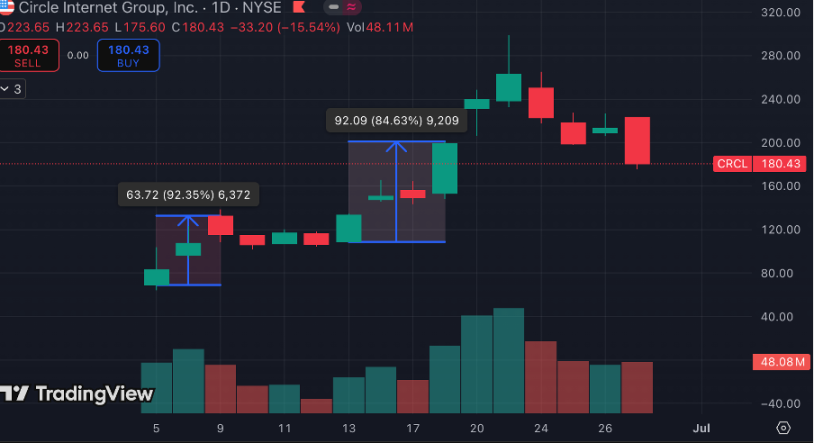
Circle's stock price gave us a very clear opportunity to observe market sentiment. The stock price soared 90% within three days of listing. You can search the news at that time. People all over the world were stunned during this period. People in the crypto thought that this lousy company should not be worth so much money, and people in the stock circle could not understand what this lousy company was doing. But the crazy stock price did attract the attention of the entire market.
This is the illogical surge stage. You can’t find the reason, you don’t understand the business, and you don’t dare to buy, so you often miss it. In fact, it’s like the love in your youth. You are moved, but you don’t know whether the relationship can last, you don’t know whether he/she will like you, and you don’t dare to invest, so you often miss it.
After a few days of consolidation, Circle's stock price did not fall. Everyone waited and watched at this stage. As the stock price continued to rise, various theories emerged.
As you can see from the second upward arrow in the picture, there are many sayings during this period, such as stablecoin, decentralized payment, replacing the banking system, new American hegemony, including the video of Mai Gang investing in Bitcoin that went viral some time ago. It is very obvious that everyone started to find excuses. These reasons are certainly not all self-deceptions. There are even some logics that will become very serious considerations for institutional investors. However, at this stage, the market presents a situation of mutual reflection. The logic of attribution and the rising stock price spiral left foot stepping on right foot, constantly pushing forward.
Later, the budget started to fall due to overheating. What will happen next is not the focus of this article. However, this illogical surge that came out of nowhere is something that everyone must adapt to, learn from, and try their best to master in this era.
At least we have to change a habit first. Don't ask why the stock price goes up when we see it goes up. If our fundamental analysis only stays at the business level, without considering the flow of funds or market sentiment, and only regards rigorous and quantifiable logic as fundamentals, then there are too many things in this world that cannot be explained.
2. No pricing
From Aristotle 2300 years ago to the atomic clocks used on spacecraft today, humans like certainty very much. First of all, it should be clear that certainty is really useful. For example, cesium atoms have a characteristic that when they transition between their two hyperfine energy levels, they will radiate electromagnetic waves of a specific frequency. They radiate electromagnetic waves of this frequency very accurately and stably. For me, this thing is really useless. I still have to drink three kilograms of water every day. It's just everyone's own characteristics. What's worth studying? But the problem lies in certainty. The characteristics of cesium atoms are very certain. Based on this point, scientists have made it into an atomic clock used on spacecraft, and the error in a year does not exceed 1 second. Bitcoin is also very certain. There are only 2,100,000,000, which are generated by a certain algorithm. So this is a string of invisible and intangible things calculated by computers, which will become a global pricing system.
This is a bit off topic, but the first point is that I just want to tell you that certainty is really useful for the development of human society. But the focus of this article is actually uncertainty. When people don’t know how to price something, there will often be a huge profit and loss space. So if an asset has the potential to enter a range that cannot be priced, and people don’t know which logic to use to measure the value of this thing, you must be careful at this time, because there will often be huge opportunities.
No pricing means no limits
The examples in this article will be very extensive. At the beginning, I said that it will include the entire capital market. In this chapter, we will give an example of "information" that cannot be priced. It is also the ancient fear of the crypto, 312.
On March 11, 2020, the World Health Organization (WHO) officially declared COVID-19 a global pandemic. This is the first global pandemic ten years after the 2009 H1N1 influenza. The capital market is completely unable to price this piece of information, and the world has changed too much in the past 10 years. The destructive power of this epidemic on the human body, the damage to the economy, and the number of deaths it will cause were unimaginable in the early stages, because the virus cannot be controlled by humans and is difficult to predict. The results calculated by several models are terrible and outrageous. If you still remember the beginning of 2020, you will really feel like a biochemical crisis.
For the capital market, first, this is bad news and the market should fall. Second, we don’t know how to price this news, which means we don’t know where the market will fall. So where will the market fall? The answer is that the market will fall wherever the sentiment goes.
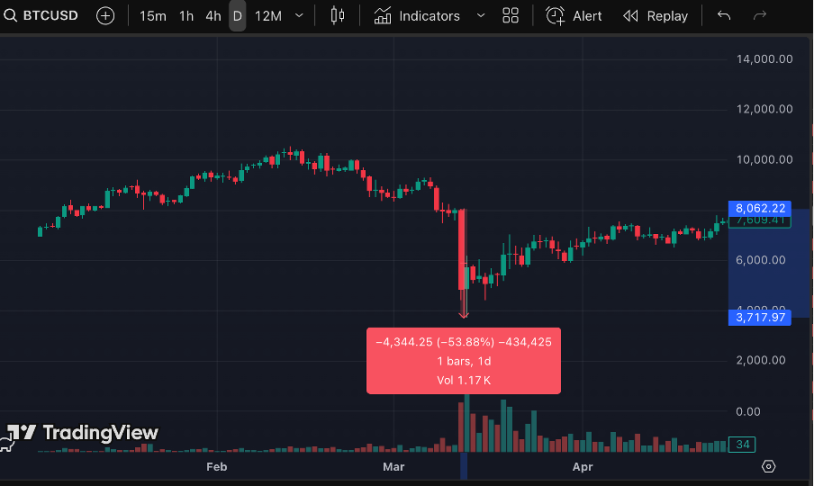
The now popular Bitcoin once fell 60% in two days.
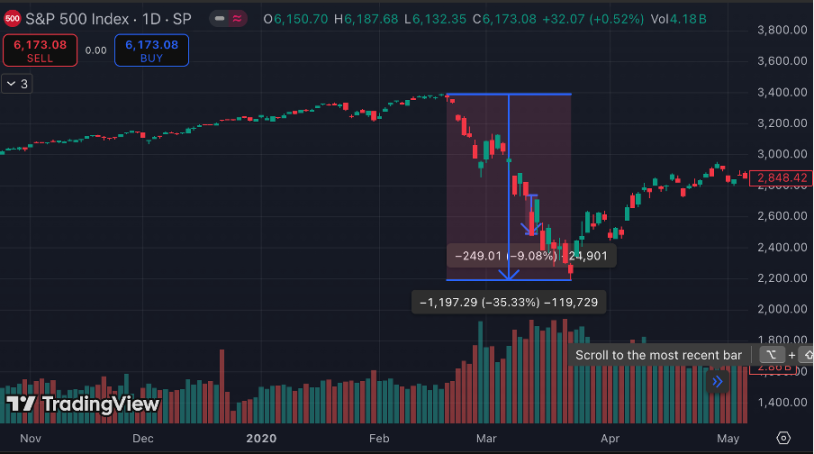
The eternal bull market S&P fell 9% in one day, and fell 35% during the digestion of epidemic information. I remember there was a meme at the time, saying that Buffett experienced a U.S. stock market circuit breaker in the first 80 years, and experienced four U.S. stock market circuit breakers within two months in 2020, so Buffett said that it seems that I am still too young.
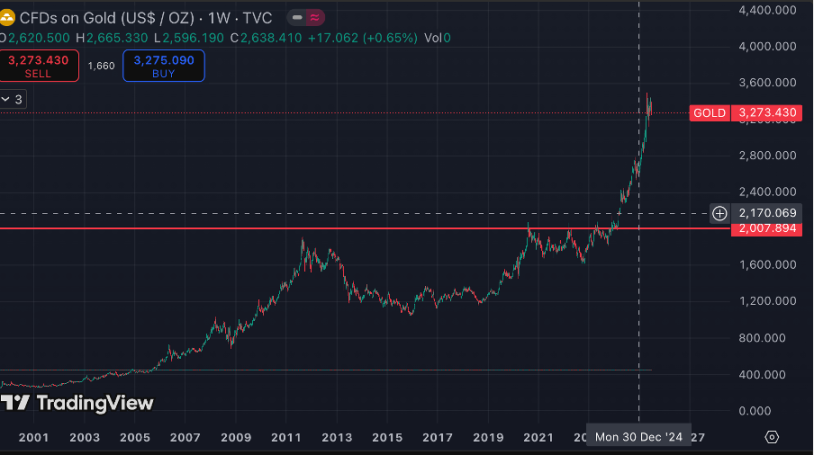
Let me give you another tangible example. One of the hottest transactions in 2024-2025 is gold. We can clearly see that gold has been hovering around the red horizontal line, which is the previous historical high, for a very long time. In the absence of obvious events, the pricing logic at this time is actually the previous high. Everyone will think that it has reached the historical high, oh, I should sell and wait. But when the price broke through the historical high, we didn’t know how to price it for a while. How much should gold be worth? Everyone was at a loss. Dear readers, please don’t think that pricing means that there must be a rigorous formula or something like that. As long as you can find a reason to convince yourself, then you are still in the pricing range. But like gold, it has entered the non-pricing range, and this is the time when it rises the fastest and the most.
The current situation of Bitcoin is very similar. We have been grinding at the historical high of around 70,000 in 2024 for a very long time. After breaking through, it will rush to 100,000, because 100,000 is a psychological price for normal people. This number looks good. But when Bitcoin officially breaks through 100,000, how should we price it? Now we can't find it. Various imaginative theories seem to all make sense.
The historical school believes that the peak of this cycle is 120,000.
The pricing school will link Bitcoin and gold together. According to the leading law, the market value of Bitcoin should be one-third of gold. In fact, this is how many traditional institutions see it.
Early geeks and fundamentalists might have thought the top was 1 million.
The narrative school believes that Bitcoin is an anchor for the future US dollar and there is no upper limit.
Anyway, everything makes sense, you can just pick the flavor you like. I just want to say that if people don’t know how to price something, then it often has huge ups and downs potential.
3. Desperate reversal: "upset" in the capital market
There is a saying that goes "buy when no one is interested, sell when everyone is talking". This saying actually well demonstrates the counterintuitive nature of the capital market. Big opportunities often appear in unpopular stocks that no one is optimistic about, while popular stocks that everyone loves have limited opportunities.
Especially those moments of reversal in despair can give great rewards. Let me give you two examples directly. The first one is the 1998 World Cup final. Are you confused, what is Dave talking about? First of all, I have to explain to you what the definition of virtual economy is. In addition to the financial industry and real estate industry that we are familiar with, the virtual economy also includes sports economy, gambling, and collection industry. So the essence of sports is actually very similar to finance, and it is also a virtual economy. The 1998 World Cup final is a classic example of "upset".
Before the game, the whole world agreed that Brazil would win France by a large margin. At that time, Brazil had a super luxurious lineup. The aliens Ronaldo, Carlos, Taffarel and others made the team have no shortcomings in every position. At the same time, the team's main player Ronaldo was the best player in the World Cup that year, with four goals and three assists. And in history, Brazil has never lost as long as it enters the World Cup finals.
The consequence of this popularity is that everyone bets on Brazil to win on a large scale. It is rumored that the odds were 1 to 6. The Asian betting market alone took away 25 billion US dollars for this game, which means that a considerable number of retail investors are playing against the bookmakers. At the same time, the bookmakers will continue to roll the odds every time the French team scores a goal, which means that they will increase the bets by a larger multiple and bet that Brazil will not score a goal. The global betting funds follow the bookmakers' rolling odds. In the end, the French team defeated Brazil 3-0. The core of the team, Ronaldinho, was sleepwalking throughout the game. The team doctor later admitted that "drug use errors" caused him to have adverse reactions. The whole team was in a very low state.
Of course, the French Congress investigated the match-fixing case and concluded that there was no match-fixing. Everyone also came out to make a series of clarifications. But this gambling game is still a classic. You can still see the 1998 episode in the God of Gamblers and the Gambler series of movies.

So, football is bought in reverse, and villas are near the sea. Don't let capital set you up, my friends.
Let me give you another tangible example, Ethereum. After ETH experienced a long period of decline and a very poor price performance, most market participants, including me, a guy who specializes in speculation, lost confidence in ETH. It is absolutely not wrong to describe it as "desperate" at this time. An unpopular asset in despair may not necessarily grow, but if it does, it will be earth-shattering.
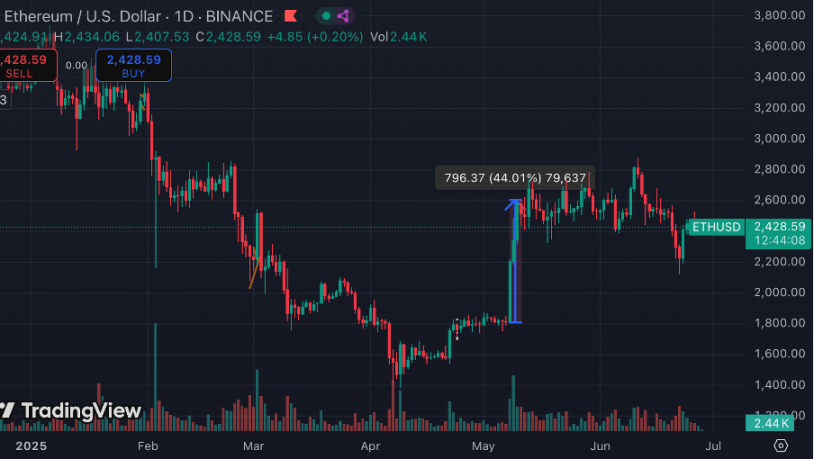
The second largest crypto in the cryptocurrency market rose by 44% in three days, leaving the dark horse SOL dumbfounded. This is the powerful force of a desperate reversal. Buffett said, "When others are fearful, I am greedy, and when others are greedy, I am fearful." This is a very insightful secret of sudden surprises and sudden rises.
4. Buy expectations and sell reality
This is what we often call the realization of expectations. Good news turns into bad news, and bad news turns into good news. If you can't understand this counterintuitive capital market, you will often be confused about some phenomena of price information linkage, such as why the stock price still fell despite good news? The truth actually lies in the quantum transformation from expectation to reality. Expectation is the sexiest thing. If I can only leave one word for the secondary market, I would choose the word "expectation". Reality is not sexy, and reality is often very skinny, so when expectations become reality, when a sexy thing becomes an unsexy thing, we need to interpret the information in reverse.
Some classic examples are the public chain upgrade of blockchain. When the public chain upgrade information is announced, everyone will have expectations about the block chain chain after the upgrade, so the price of the corresponding token will be pushed up. However, when the public chain is officially upgraded and the high-speed and efficient functions we expect are officially realized, the token price will fall instead.
The most classic example is the approval of the Bitcoin ETF on January 10, 2024. I was interning in Shanghai at the time, and I really set an alarm at 3:00 a.m. to check the news. In the expected period from the end of 2023 to the beginning of 2024, the price of Bitcoin climbed from about $30,000 to about $48,000, with a strong "buy expectation". On January 10, 2024, the SEC announced the approval of the ETF. Then:
4. Buy expectations and sell reality
This is what we often call the realization of expectations. Good news turns into bad news, and bad news turns into good news. If you can't understand this counterintuitive capital market, you will often be confused about some phenomena of price information linkage, such as why the stock price still fell despite good news? The truth actually lies in the quantum transformation from expectation to reality. Expectation is the sexiest thing. If I can only leave one word for the secondary market, I would choose the word "expectation". Reality is not sexy, and reality is often very skinny, so when expectations become reality, when a sexy thing becomes an unsexy thing, we need to interpret the information in reverse.
Some classic examples are the public chain upgrade of blockchain. When the public chain upgrade information is announced, everyone will have expectations about the block chain chain after the upgrade, so the price of the corresponding token will be pushed up. However, when the public chain is officially upgraded and the high-speed and efficient functions we expect are officially realized, the token price will fall instead.
The most classic example is the approval of the Bitcoin ETF on January 10, 2024. I was interning in Shanghai at the time, and I really set an alarm at 3:00 a.m. to check the news. In the expected period from the end of 2023 to the beginning of 2024, the price of Bitcoin climbed from about $30,000 to about $48,000, with a strong "buy expectation". On January 10, 2024, the SEC announced the approval of the ETF. Then:
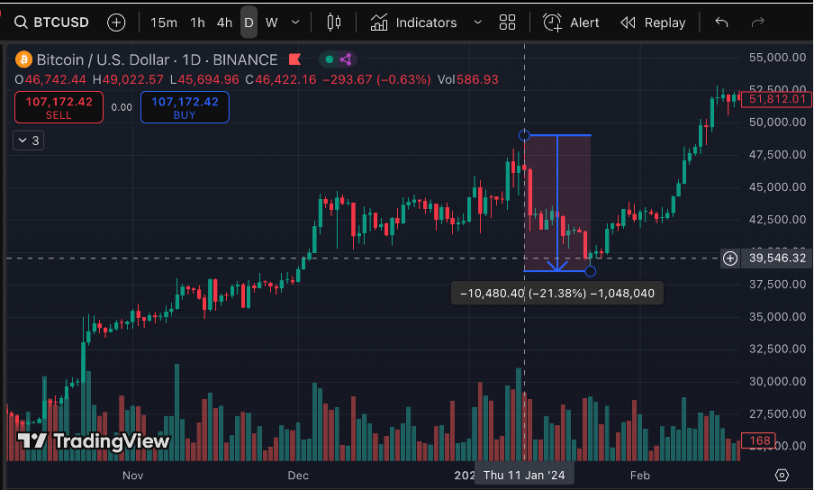
Interested friends can search for it by themselves. Why did the price of Bitcoin fall after the ETF was passed? Everyone has done a very detailed attribution analysis of this event, which is very good. But if we only look at it intuitively, we can't understand it. There was no off-market capital inflow before the ETF was passed, and off-market capital could flow in after the ETF was passed. Why did the price rise when there was no capital inflow, and the price began to fall after the inflow? Expectations, or expectations.
To make a small summary, if it is unexpected news, you can interpret it logically, such as the US Federal Reserve suddenly announced a rate cut, which was unexpected and the price rose. If it is expected news, you should interpret it in the opposite way, such as the gold ETF (GLD) was listed in 2004, and the gold price also experienced a short-term pullback after listing, because the market has digested the good news in advance.
Conclusion:
The entire series of Level 2 Unveiling is based on rigorous reasoning and logic, but this article breaks with the past style and discusses the irrationality in the market. We need to recognize the change of formalization from the perspective of macroeconomics. Since the turning point of the economic cycle in 2020, the world has entered a period of great uncertainty: the Russian-Ukrainian war, the 20th National Congress of the Communist Party of China and the epidemic policy, the endless war in the Middle East, and Trump's entry into the White House. These trends have injected considerable and uncomfortable turbulence into the macroeconomics.
Irrational markets are not new. As early as in Soros's book Financial Alchemy, he proposed market reflexivity, which is a challenge to the rational market assumption for a hundred years. However, in today's world, the information explosion brought about by technological progress, political uncertainty and polarization, and the changes in the economic foundation since the third industrial revolution that have changed the three perspectives of the new generation's consumption power, these three factors at different levels interact with each other, and the triple resonance infinitely amplifies the impact of emotions, and the market deviates significantly from the rational valuation line.
The subtle changes in the development model of asset trading actually reflect the structural changes of market participants. Looking at the entire history of the financial market, we seem to have changed from a classical investor who graduated from the Department of Philosophy at Cambridge University with an artistic atmosphere to a modern investor who graduated from MIT Statistics with a technical atmosphere, and now to a personality investor who dropped out of Hong Kong University of Science and Technology to do rock music. From Buffett to Ken Griffin to Labubu.
These changes force us to face human nature, primitive human nature. It is so complex, so vague, so hard to figure out, but it also contains such great opportunities. It is like the pirates encountering Treasure Island, Qin Shihuang encountering the elixir of immortality, and White Snake encountering Xu Xian. It is like hearing the truth in the morning and dying in the evening in the midst of danger. This article is to use simple words to reveal the tip of the iceberg of this huge topic.







